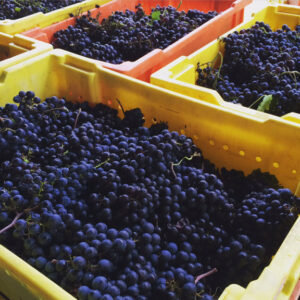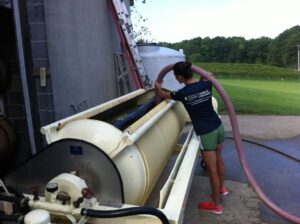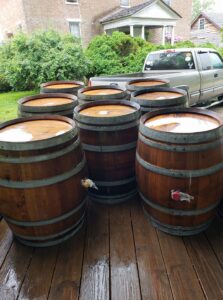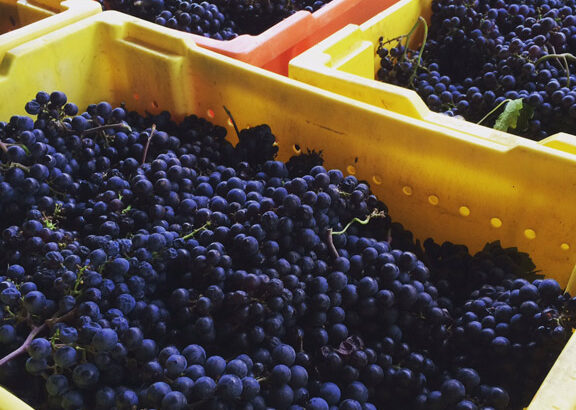Harvest is a busy time on the Chesapeake Bay Wine Trail and perhaps the most exciting time of the year for wineries. Wine grapes undergo a process the French call “veraison” (verr-ray-zohn), in which grapes naturally sweeten and turn from small, hard, green berries to soft, plump grapes in purple/red and translucent gold hues. At the time of peak ripeness, (generally late summer/early fall), winery staff (and sometimes volunteers) pluck these grapes from the vines to begin their transformation into wine.
GRAPE (AND APPLE) PICKING

Visiting a winery during harvest is fascinating! Guests get a front-row seat to the winemaking process, from hand- or machine-grape picking to crushing/pressing to fermentation.
The exact timing of grape harvesting can vary, with weather being a major factor in determining when to pick. Weather that is too hot, too rainy, or even a freak cold snap, can force an earlier or later harvest; and can also affect the development of the grapes. Cooler growing conditions can inhibit ripening, making grapes more tart, with higher acidity and lower sugar and alcohol level. Warmer growing conditions result in a riper, sweeter grape that has more sugar and a higher alcohol level.
Winemakers and vineyard staff visit the vines daily before harvest, monitoring sugar, acidity, and tannin levels. Grapes used for higher acidic wines, such as sparkling wine, are generally picked first. Red wine grapes, such as Cabernet Sauvignon, may require more time to mature; thus, may be left on the vines a little longer.

When the time is right, wineries begin their harvests, often picking grapes around the clock. Grape-picking can be by hand or mechanical. Special equipment may be used, such as a grape hook knife, a tool with a curved blade or hook used to cull grapes that are under-ripened, over-ripened or blemished. Lugs are containers used to hold grapes during handpicking, before being transferred to bigger bins and taken to the winery.
Some Trail members, such as Good Luck Cellars, welcome volunteers to help handpick grapes from its 25 acres of vines. Volunteers are rewarded with “good luck” (wine) in return for their time and efforts.
Mechanical harvest requires pivotal strikers or trunk shakers, which shake grapes off the vines. Though less gentle on the grapes than handpicking, mechanical picking is faster and easier, though may result in a lower yield of usable grapes.
Ditchley Cider Works, the lone cidery on the Chesapeake Bay Wine Trail, is busy harvesting apples destined for the cool room, where they will stay fresh until processed and turned into cider.
CRUSHING/PRESSING

Wine grapes are processed differently, depending on their variety and by winery. Red grapes are usually crushed to break the skins and release some juice. The resulting mixture is called the “must”. Some wineries will destem the must, while others remove no solid matter prior to starting the fermentation process. Pressing is done after the fermentation process, either by hand or via a wine press.
White grapes are generally pressed immediately after harvest, thus, releasing the juice from the skins prior to fermentation. Rosé is made by pressing off some of the juice from red grapes, and then fermenting this juice in the same manner as a white wine. The juice is pink when it gets pressed off, giving rosé its distinct color. There are also “orange” wines, which are white wines which are fermented with the skins.
FERMENTATION/CLARIFICATION/AGING & BOTTLING

After crushing, red wine grapes are left to soak in their juices during a process called maceration, which intensifies the color and allows for the extraction of phenolics (flavor and aroma compounds.) Naturally occurring wild yeast from the vineyard starts the fermenting process, added yeast completes the process, which can last anywhere from several days to over a week. Generally, the longer the maceration and fermentation period, the more tannins, color, and flavors will be extracted, thus, the more full-bodied and redder the wine will be.
Fermentation for all varieties is complete once the yeast has consumed all the sugar in the grapes. Clarification follows, which includes the filtering of large particles and the fining of small microbes.
The final step of winemaking is aging and bottling. Many factors affect the vinter’s (winemaker) decision as to how long to further age the wine, and what type of container to age it in. Depending on the grape varietal, flavor profile, mouthfeel (how a fine feels in the mouth: texture, weight, etc.), and other characteristics, vinters may choose to age wine in stainless steel vats or oak barrels, for months or years before bottling.
AUTUMN HARVEST IN VIRGINIA WINE COUNTRY
The end of harvest season typically coincides with Virginia’s peak fall foliage viewing: between October 10 and 31. Start planning your autumn getaway now!
The Chesapeake Bay Wine Trail is located primarily within the Northern Neck National Heritage Area (NNK), one of Virginia’s most picturesque rural regions. A peninsula bordered by the Potomac River, Rappahannock River, and Chesapeake Bay, the NNK is home to three Virginia State Parks (Westmoreland, Caledon, and Belle Isle) and additional nature areas, making it an ideal place to view fall foliage via walking, hiking, riding, or boating. The rural area boasts miles of countryside, including small towns that host charming autumn events, pumpkin patches, parades, and more. Stock up on cider from the Trail member Ditchley Cider Works!
Visit the Itineraries page on our website for ideas on Trail wineries to visit, local lodging (some onsite at Trail member locations including Ditchley, The Dog and Oyster, General’s Ridge Vineyards, and Monroe Bay Winery), and nearby attractions.
Planning an autumn wedding? Visit the wineries on the Trail this season, including Caret Cellars, Jacey Vineyards, and Rivah Vineyards at the Grove, to see how a winery’s fall foliage makes a breathtaking backdrop for wedding photos!
Share This Post!
